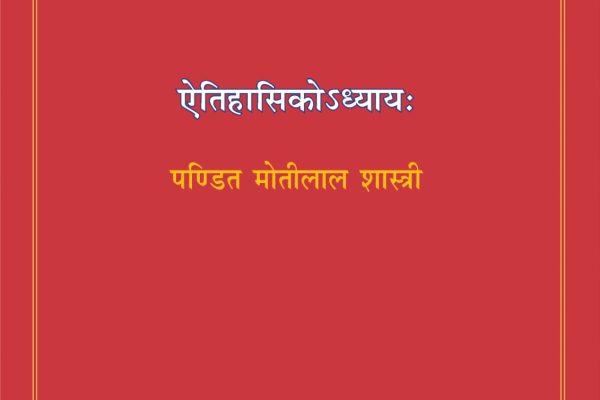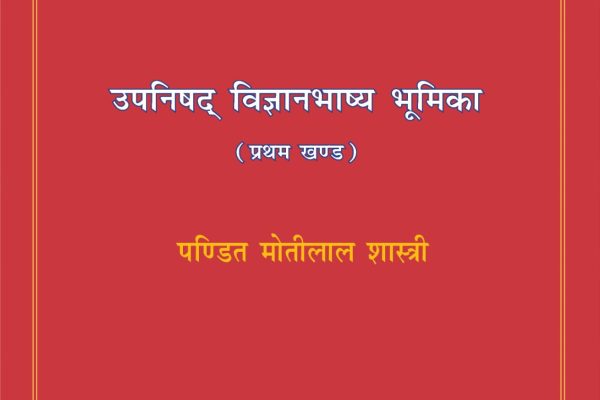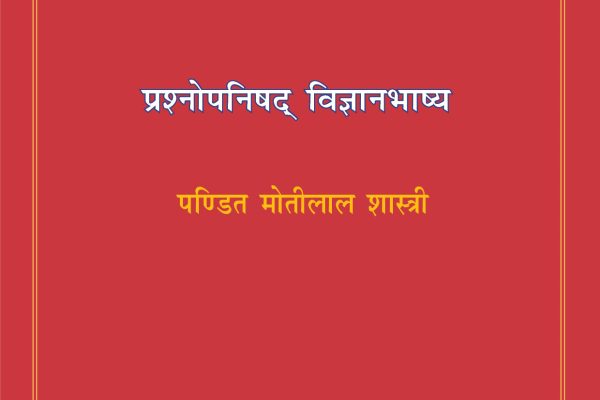- 011-688228078
- ssst.2015@gmail.com
- Shri Shankar Shikshayatan, New Delhi-
Category: Pandit Motilal Shastri Works

Bhakti-yoga-pariksha Part I and II
Pandit Motilal Sharma has explained the genesis, profile and characteristics of bhaktiyoga. He argues that when jnanayoga and karmayoga failed to address all the issues, bhaktiyoga came into existence. Both jnanayoga and karmayoga formed part of bhaktiyoga. Shastriji has defined bhaktiyoga as the path in which materials are adibhautik and objective is adhidaivik. भक्ति-योग-परीक्षा भाग 1 भाग 2 पंडित मोतीलाल शर्मा ने भक्तियोग की उत्पत्ति, रूपरेखा और विशेषताओं के बारे में बताया है। उनका तर्क है कि जब ज्ञानयोग और कर्मयोग सभी मुद्दों को संबोधित करने में विफल हो गए, तो भक्तियोग अस्तित्व में आया। ज्ञानयोग और कर्मयोग दोनों ही भक्तियोग का हिस्सा थे। शास्त्रीजी ने भक्तियोग को उस मार्ग के रूप में परिभाषित किया है जिसमें पदार्थ आदिभौतिक होते हैं और वस्तु आधिदैविक होती है। Read/Download Part IRead/Download Part II

Budhi-yoga-pariksha Uttarakhand and Purvakhand
This is the ninth book in the series of commentaries written by Pandit Motilal Shastri on Bhagavad Gita. In a way, it is a summary of all the previous eight books on the subject. Shastriji has tried to explore the meaning of Gita through various ways, especially the worldly view. बुद्धि-योग-परीक्षा यह पंडित मोतीलाल शास्त्री द्वारा भगवद्गीता पर लिखी गई टीकाओं की श्रृंखला की नौवीं पुस्तक है। एक तरह से यह इस विषय पर लिखी गई पिछली सभी आठ पुस्तकों का सारांश है। शास्त्री जी ने गीता के अर्थ को विभिन्न तरीकों से, खास तौर पर सांसारिक दृष्टिकोण से समझने की कोशिश की है। Read/Download Uttarakhand Read/Download Purvakhand

Jnana-yoga-pariksha
Pandit Motilal Shastri has pointed out in this book that Gita was the ultimate bibliography of veda shastra. Principles, theories and concepts contained in the Vedas finds reference in Gita. ज्ञान-योग-परीक्षा पंडित मोतीलाल शास्त्री ने इस पुस्तक में बताया है कि गीता वेदों का सर्वोच्च ग्रंथ है। वेदों में निहित सिद्धांतों, सिद्धांतों और अवधारणाओं का उल्लेख गीता में मिलता है। Read/Download

Atmapariksha
Gita shastra focuses primarily on budhiyoga. But it also highlights atma, brahmakarma, karmayoga, jnanayoga and bhaktiyoga. Understanding these six topics is essential to realise the true meaning of Gita. आत्मपरीक्षा गीता शास्त्र मुख्य रूप से बुद्धियोग पर केंद्रित है। लेकिन इसमें आत्मा, ब्रह्मकर्म, कर्मयोग, ज्ञानयोग और भक्तियोग पर भी प्रकाश डाला गया है। गीता के सही अर्थ को समझने के लिए इन छह विषयों को समझना आवश्यक है। Read/Download

Gita-nama-rahasya
There is a detailed meaning of various terms given in Gita. Pandit Motilal Shastri has presented a comprehensive meaning of terms like Gita, Upanishad and Bhagvat. गीता-नाम-रहस्य गीता में विभिन्न शब्दों का विस्तृत अर्थ दिया गया है। पंडित मोतीलाल शास्त्री ने गीता, उपनिषद और भागवत जैसे शब्दों का व्यापक अर्थ प्रस्तुत किया है। Read/Download

Gita-Shastra-rahasaya
In this book, Pandit Motilal Shastri makes an attempt to answer the following questions: What is the real secret of Gita? What is Gita understood as? How has Gita divided into chapters to make answers possible? Shastriji has presented a detailed explanation through 18 chapters on yoga in Gita. गीता-शास्त्र-रहस्य इस पुस्तक में पंडित मोतीलाल शास्त्री निम्नलिखित प्रश्नों के उत्तर देने का प्रयास करते हैं: गीता का वास्तविक रहस्य क्या है? गीता को किस रूप में समझा जाता है? उत्तरों को संभव बनाने के लिए गीता को किस प्रकार अध्यायों में विभाजित किया गया है? शास्त्री जी ने गीता में योग पर 18 अध्यायों के माध्यम से विस्तृत व्याख्या प्रस्तुत की है। Read/Download

Aithihasikodhyaya
Aithihasikodhyaya is part of Pandit Motilal Shastri’s Gitavijnana-bhashya. In this compact volume, Shastriji has described the epic battle between the Kauravas and Pandavas in a vivid explanation of the word, Kurukshetra. ऐथिहासिकोआध्याय ऐथिहासिकोआध्याय पंडित मोतीलाल शास्त्री रचित गीताविजय-भाष्य का हिस्सा है । इस संक्षिप्त खंड में, शास्त्री जी ने कौरवों और पांडवों के बीच महाकाव्य युद्ध का वर्णन कुरुक्षेत्र शब्द की विशद व्याख्या में किया है । Read/download

Upanishad vijnana bhashya
During the study of Upanishads and their commentaries, Shastriji discovered there were several disputes that need to be resolved scientifically. He decided to write a long essay on the subject. This essay, since then, has been divided into three volumes. In the first volume, the following have been elucidated: 1.Introduction; 2. Why is mangalacharan recited before and after the reading of Upanishads? 3. What is the meaning of Upanishad? and 4. Are Upanishads Veda? The introduction examines the skepticism about the Upanishads prevalent among modern Indians. Why is such profound knowledge ignored by the people? उपनिषद विज्ञानभाष्य–प्रथम भाग उपनिषदों और उनकी टिप्पणियों के अध्ययन के दौरान, शास्त्रीजी ने पाया कि कई विवाद थे जिन्हें वैज्ञानिक रूप से हल करने की आवश्यकता है । उन्होंने इस विषय पर एक लंबा निबंध लिखने का फैसला किया । तब से यह निबंध तीन खंडों में विभाजित है । पहले खंड में, निम्नलिखित को स्पष्ट किया गया है: 1.परिचय; 2. उपनिषदों के पढ़ने से पहले और बाद में मंगलचरण का पाठ क्यों किया जाता है? 3. उपनिषद का अर्थ क्या है? और 4. क्या उपनिषद वेद हैं? परिचय आधुनिक भारतीयों के बीच प्रचलित उपनिषदों के बारे में संदेह की जांच करता है । लोगों द्वारा इस तरह के गहन ज्ञान की अनदेखी क्यों की जाती है? Read/download Upanishad Vijnana Bhashya Part II The second volume continues with the examination of whether the Upanishads are Veda. In the first volume, an overview of the same has been given. It is unfortunate that such a profound knowledge is lost on the present generation. It is clear that the people of this country have relied more on words given in veda-shastra than the true meaning of this knowledge. Do we need to forever validate the upanishad? उपनिषद विज्ञानभाष्य–भाग द्वितीय दूसरा खंड इस बात की परीक्षा के साथ जारी है कि क्या उपनिषद वेद हैं । पहले खंड में उसी का अवलोकन दिया गया है । यह दुर्भाग्यपूर्ण है कि वर्तमान पीढ़ी पर इतना गहरा ज्ञान खो गया है । यह स्पष्ट है कि इस देश के लोगों ने इस ज्ञान के वास्तविक अर्थ की तुलना में वेद-शास्त्र में दिए गए शब्दों पर अधिक भरोसा किया है । क्या हमें हमेशा के लिए उपनिषद को मान्य करने की आवश्यकता है? Read/download Upanishad Vijnana Bhashya Part III The final volume of the commentary is called vedanta. Keeping Brahma at the centre, the volume explains the basic explanations of science of the universe. The volume also deals with the profound question whether the Upanishad is man-made or not. उपनिषद विज्ञानभाष्य –भाग तृतीय टीका के अंतिम खंड को वेदांत कहा जाता है । ब्रह्मा को केंद्र में रखते हुए, यह ग्रंथ ब्रह्मांड के विज्ञान की बुनियादी व्याख्याओं की व्याख्या करता है । यह ग्रंथ इस गहन प्रश्न से भी संबंधित है कि उपनिषद मानव निर्मित है या नहीं । Read/download Ishopanishadvigyanbhashyaईशोपनिषद्विज्ञानभाष्यRead/Download Kenopanishadकेनोपनिषद् Read/Download Mundakopanishadमुण्डकोपनिषद् Read/Download Mandukyopanishadमाण्डूक्योपनिषद् Read/Download

Prashnopanishad-vijnana-bhashya
Prashnopanishad is an important Upanishad. Pandit Motilal Shastri has referred to it as Pippalodapanishad or Pranopanishad. There are six questions in this upanishad. These are on parameshti mahan, saur vijnanatma, chandra pragyanatma, parthiv pranatmaka, svaymbhu avavyatma and purushatma. The bashya gives a detailed account of these. It is considered to be one of the finest works of Shastriji. Shodashi purusha is infused with five pranas–avyaktaprana, mahatprana,vijnanaprana,pragyanprana and pashuprana. These are in some definitions termed as vishvasrit. These are termed as prana, apah,vaka, anna and annada–the brahmasatya. प्रशनोपनिषद-विज्ञान-भाष्यप्रशनोपनिषद एक महत्वपूर्ण उपनिषद है । पंडित मोतीलाल शास्त्री ने इसे पिपलोदापनिषद या प्राणोपनिषद कहा है । इस उपनिषद में छह प्रश्न हैं। ये परमशक्ति महान, सौर विज्ञान, चंद्र प्रज्ञानात्मा, पार्थिव प्राणात्मक, स्वयंभू अवव्यात्मा और पुरुषात्मा पर हैं । यह शास्त्रीजी की बेहतरीन कृतियों में से एक मानी जाती है । षोडशी पुरुष पांच प्राणों से प्रभावित है-अव्यक्त, महात्माना,विज्ञानप्राना,प्रज्ञानप्राना और पशुप्राना । इन्हें कुछ परिभाषाओं में कहा जाता है विश्वाश्रित । इन्हें प्राण, पापा, वाका, अन्ना और अन्नदा कहा जाता है-ब्रह्मा सत्य । Read/download
